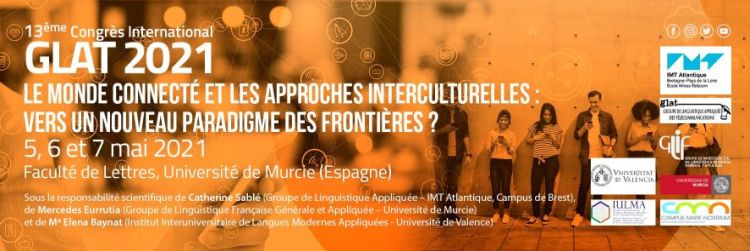|
Le monde connecté et les approches interculturelles : vers un nouveau paradigme des frontières ?
GLAT 2021 : 5, 6 et 7 mai 2021 Colloque en ligne LE MONDE CONNECTÉ ET LES APPROCHES INTERCULTURELLES : VERS UN NOUVEAU PARADIGME DES FRONTIÈRES 13èmeCongrès International du GLAT sous la responsabilité scientifique de Catherine Sablé (Groupe de Linguistique Appliquée - IMT Atlantique, Campus de Brest), de Mercedes Eurrutia Cavero (Groupe de Linguistique Française Générale et Appliquée - Université de Murcie) et de Elena Baynat (Institut Interuniversitaire de Langues Modernes Appliquées – Université de Valence, Espagne) Depuis les approches phénoménologiques, on sait que nous co-construisons la réalité avec nos perceptions, nos appréhensions du monde. Le monde est-il ce que nous percevons ? En effet, notre capacité de perception est, à de nombreuses reprises, conditionnée par des facteurs qui déterminent notre conception des choses, des personnes, de l'espace, du temps. Nos relations sociales, nos processus de culturalisation, les progrès technologiques et la consommation du contenu médiatique nous ont amenés à générer des processus d'apprentissage social qui nous déplacent culturellement. À la suite des progrès technologiques et des mutations des sociétés contemporaines, nous vivons dans une époque où d'une part, une nouvelle perspective se dessine vers une société interculturelle qui affirme la nécessité des normes et d'un langage communs, basée sur la reconnaissance de la diversité culturelle, sur l'ouverture de différents ensembles culturels et sur l'acceptation du changement. Une société, d'autre part, où les technologies de l'information et de la communication ont pris une place décisive, notamment dans le domaine de l'apprentissage et de l'acquisition de la compétence interculturelle, c'est-à-dire, de la « manière d'analyser la diversité culturelle » (Meunier, 2007). Dépassant la simple comparaison et/ou l'identification à un autre groupe culturel, l'interculturel bâtit des passerelles entre les cultures dans le but d'un échange et d'un enrichissement mutuel, tout en ouvrant une nouvelle perspective : celle des regards croisés. En effet, le concept de compétence interculturelle présuppose des connaissances et des savoir-faire d'ordre linguistique mais également d'ordre social et/ou anthropologique qui rajoutent à la notion de culture une dimension beaucoup plus ample. L'individu y est situé en tant qu'être social qui excède le simple statut de produit de sa culture pour en constituer l'un de ses principaux acteurs ; langue et culture deviennent, dans ce contexte, le « lieu de mise en scène de soi et d'autrui » (Abdallah Pretceille, 1999). Que devient cette mise en scène dans ce monde connecté en permanence, c'est-à-dire passant toujours par une médiation comme « processus de transformation [...] produit sur les comportements [par] le dispositif technique » ? (Burton et al., 2011) ? Actuellement, un regard porté sur des terrains multiples qui ont vocation ou qui, tout simplement, apparaissent comme des vecteurs idéaux de formation interculturelle nous poussent à constater que la société interculturelle, pour reprendre le titre de Verbunt (2005), est ambigüe. Ainsi, ces mêmes espaces médiatiques qui favorisent les relations interculturelles, qui permettent la construction d'une culture globale, -on pense aux nombreux projets européens (formation, recherche), aux nombreuses collaborations économiques internationales- qui semblent également favoriser les manipulations idéologiques. L'interculturel devient violence, rappelant en cela les propos de Demorgon : C'est à travers les discours dans les médias, dans les réseaux sociaux, dans les espaces de formations variés, appréhendés comme micro-société interculturelle que cette question pourra être abordée. La notion de frontières est ainsi à repenser face à ce monde globalisé virtuel qui traverse le temps et l'espace et qui peut mener, à la fois à l'ouverture et à la connaissance/reconnaissance de l'autre, mais aussi à la création de nouvelles frontières/barrières par exemple les groupes mondialisés qui se retrouvent au nom de la haine de l'autre. Des discours exprimant des couples a priori contradictoires semblent ainsi émerger lorsqu'il s'agit d'interculturel : global face au local, internationalisation/hybridisation, etc. L'objectif du GLAT 2021 est, en définitive, d'interroger, dans une approche interdisciplinaire et plurilingue, ces espaces connectés qui favorisent le commun des diversités afin de comprendre quels représentations et paradigmes sur l'interculturel et les relations à l'Autre, ces espaces cherchent à développer. Pour cette 13ème édition du colloque international du GLAT, une table ronde s’ajoutera aux conférences et communications. Les communications pourront s'orienter autour des 5 axes thématiques suivants : AXES THÉMATIQUES I. Linguistique Appliquée et TIC : nouveaux échanges interculturels 1. Scénario mixte (présentiel/virtuel) : possibilité de suivre le congrès en présentiel (à la Faculté des Lettres de Murcia) ou en virtuel (suivi des séances en direct ou en différé). 2. Scénario virtuel : toutes les séances retranscrites par visioconférences. Les tarifs ont été revus selons ces scénarios. Vous les trouverez à la rubrique TARIFS. BIBLIOGRAPHIE D'ORIENTATION
|
| Personnes connectées : 2 | Vie privée |

|

